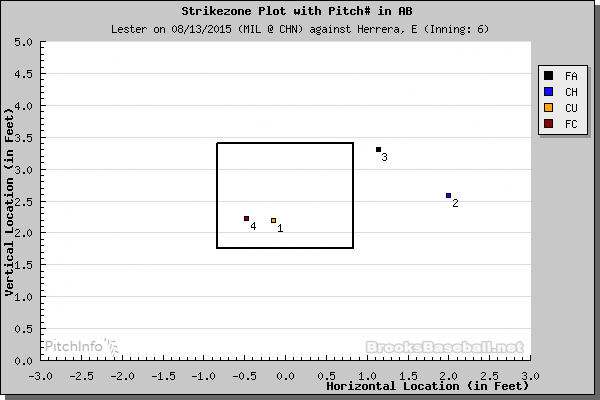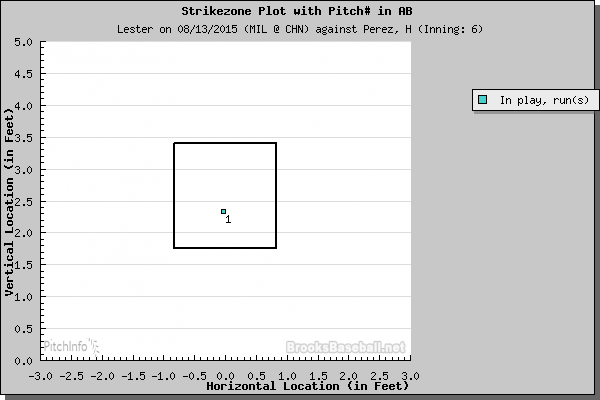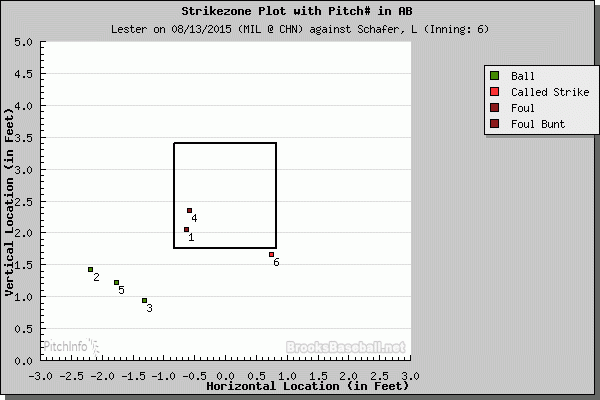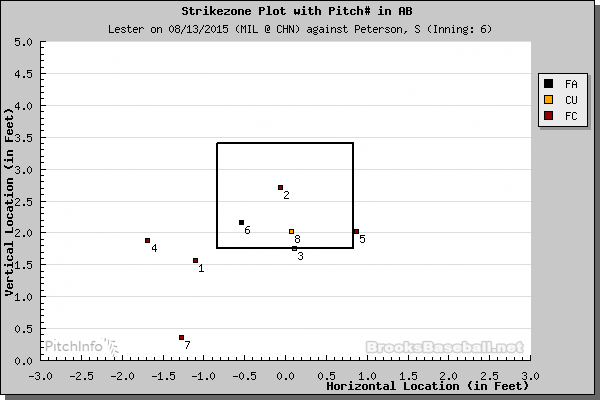Date: August 13, 2015
Opponent: Milwaukee Brewers
Location: Wrigley Field
Introduction
What a difference three months can make. When Jon Lester faced the Milwaukee Brewers on May 1st, he was coming off a frustrating first month in a Cubs uniform, and sported a 6.23 ERA and 2.031 WHIP. Lester was in the midst of a turbulent transition—pitching with the weight of a $155 million contract, while adjusting to his seventh pitching coach since the end of 2010 and an abbreviated spring training.
He righted himself that Friday afternoon against the Brewers, allowing no runs on three hits and one walk in seven innings. Lester was efficient (90 pitches) and effective, and the Cubs won 1-0. Since then, and not just since mid-July as some believe, Lester has been among the best pitchers in baseball.
He was not quite as dominant or efficient on Thursday. He had just one 1-2-3 inning, and he needed at least 22 pitches in three different innings. The nine base runners allowed were his most in a game since June 9th at Detroit.
The end results, however, were still impressive. A start after being unable to throw it past Giants hitters (four strikeouts, eights whiffs), Lester recorded 16 whiffs, among his highest totals of the season. Of the 16 whiffs, 11 came on pitches outside the strike zone, his highest total of the season. Lester’s 10 strikeouts were his fourth double-digit strikeout game of 2015, a record for a Cubs left-handed pitcher.
He got ahead 17 of 27 batters (63 percent), above his season average. Lester was strong out of the gate, throwing 12 strikes on 16 pitches (see Pitch Breakdown section) in the first inning, while striking out the side.
What is fascinating is how Lester and David Ross attacked Brewers hitters. They went to his big three pitches—four-seam fastball, cut fastball, curveball—97 of 105 (92.4 percent), his second-highest frequency of the season. A week after it was so effective, he stayed away from his sinker (see Pitch Breakdown section).
The 2015 Brewers are a decidedly mediocre, middle-of-the-road offense in nearly every respect. Entering Thursday afternoon, the team ranked between eighth and 12th in the NL in runs scored, walk rate, doubles, home runs, OBP, SLG, and OPS. Just two players (Ryan Braun and Adam Lind) rank among the NL’s top 50 in wRC+ and OPS. The team is not overly patient at the plate, as you can deduce from their 11 whiffs on pitches outside of the strike zone. Entering the game, the Brewers swing at the higher percentage of pitches (50.2 percent) in the NL.
As mediocre as is the team’s overall offense, it is downright dismal against left-handed pitchers. The Brewers entered the game hitting left-handers at .217/.277/.367. They did have eight right-handed hitters in the lineup, but Brewers right-handers hit lefties at just .209/.270/.368
Lester was far from his best against this average offense, but he was more than good enough. Lester failed to pitch into the seventh inning for the first time since June 25th against the Los Angeles Dodgers, but still reached 10 strikeouts and kept the ball in the park. It was not his most memorable or dominant start, but Lester was pretty good, and that is all the Cubs needed on Thursday. Scroll down a half-inch to learn more about Lester continuing to pitch like an ace.
Traditional Line
6.0 IP, 7 H, 10 K, 2 BB, 2 ER
Pitch Breakdown
105 pitches (67 strikes)
| Total | Velocity (Max) | AVG | SLG | BABIP | |
| Four-Seam | 48 | 93.0 (95.2) | .333 | .333 | .400 |
| Cutter | 32 | 88.3 (90.6) | .346 | .546 | .667 |
| Sinker | 5 | 92.2 (93.5) | .000 | .000 | .000 |
| Change-Up | 3 | 84.3 (85.2) | .000 | .000 | .000 |
| Curveball | 17 | 75.8 (80.0) | .200 | .200 | 1.000 |
A start after we praised his sinker, Lester threw his lowest percentage of sinkers in a game (4.8 percent) since his previous start against Milwaukee in May. While a few players in the Brewers starting lineup on Thursday have struggled against the pitch in 2015, most have an excellent career track record against sinkers from left-handed pitchers:
| Player | 2015 vs. Sinkers from LHP | Career vs. Sinkers from LHP |
| Jean Segura | .306 | .330 |
| Jonathan Lucroy | .133 | .546 |
| Ryan Braun | .667 | .626 |
| Khris Davis | .167 | .471 |
| Jason Rogers | .143 | .143 |
| Elian Herrera | .579 | .550 |
| Hernan Perez | .667 | .500 |
| Logan Schafer | .000 | .476 |
Of the eight position players in the lineup, six entered the game slugging .471 or higher against the pitch. Despite going to his sinker 15 percent of pitches (15 of 100) against the San Francisco Giants, Lester and David Ross stayed away from it against the sinker-bashing Brewers lineup. In fact, after the first inning, Lester threw just two sinkers.
As mentioned in the Introduction section, Lester relied exclusively on his four-seamer, cutter, and curve. Lester threw his highest frequency of four-seam fastballs since June 9th at Detroit.
However, of Lester’s 13 strikeouts in his past two starts, just one has come via the four-seamer. While his average velocity with the four-seamer in the two starts (92.99 mph) has been above his season average (92.68 mph), his two-strike usage has dropped significantly:
Starts 1-21
| Two Strike Usage | Four-Seam | Cutter | Curve |
| vs. RHH | 39% | 26% | 27% |
| vs. LHH | 40% | 44% | 9% |
Starts 22-23
| Two Strike Usage | Four-Seam | Cutter | Curve |
| vs. RHH | 17% | 46% | 22% |
| vs. LHH | 18% | 59% | 24% |
Has Lester lost his confidence to put away battters with his four-seamer? After two games, it might be too early to draw any firm conclusions—but we can speculate baselessly all we want! In Lester’s two August starts, 12 of the 13 strikeouts have come via the cutter (7) and curve (5).
This is your weekly, and sometimes twice weekly, reminder that Lester’s curve ball remains his best pitch in 2015. On Thursday, four of his 10 strikeouts (and six of 16 whiffs) came off the curve. Since July 1st, a span of eight starts, opposing batters are slugging just .065 against the pitch, without an extra-base hit. And despite throwing just 15.9 percent curves during that stretch, one-third of his strikeouts (22 of 66) have come off the pitch.
Trends
The Trends section of the Ballad of Jon Lester has focused, almost exclusively, on pitching trends involving Jon Lester. This particular Trends section, however, will be a one-time deviation to focus on the two-game trend of the Cubs providing Lester with real run support. Prior to August, the Cubs had scored zero or one run in 10 of 21 starts made by Lester.
In Lester’s two August starts, the Cubs offense has scored more combined run (16) than they did in all six of his July starts (13). The team’s 12 extra-base hits over the two games is the same amount as the previous seven starts combined, dating back to June 25th. Dexter Fowler and Kyle Schwarber have done the damage from the top two spots in the lineup, going a combined 10-for-17 with two doubles and four home runs.
Even with the recent offensive outburst, Lester is still receiving the sixth-lowest run support in the NL at 3.17 runs per game.
Key At-Bat/Sequence
Inning: Sixth Inning
Score: 5-2, Cubs leading
Situation: Hernan Perez on second base, one out
Batter(s): Logan Schafer and Shane Peterson
The sixth inning has not been kind to Lester in 2015. His 4.42 ERA, 1.446 WHIP, and .788 opponent’s OPS are all his worst numbers in any inning this season. That trend nearly continued on Thursday.
With one out, Lester surrendered a double to Elian Herrera on an 88 mph cutter that caught too much of the plate, after he fell behind with a curve and changeup way off the plate:
Now with one out and Hernan Perez at the plate, Lester started him with a 73 mph curve that stayed up and over the plate:
Perez lined a single to left-center field to bring in Herrera and cut the Cubs lead to three. It was good pitch selection, as Perez had never recorded a hit against a curve from a left-handed pitcher in his career. Lester’s execution was just poor.
With the tying run now on deck, Lester faced Logan Schafer. In Schafer’s previous at-bat in the fourth inning, he struck out Schafer on a curve. In this at-bat, Lester stayed strictly with four-seamers and cutters. With the count full, Lester went to his cutter, after he fell behind earlier in the at-bat with two cutters that missed off the plate:
Schafer took an 87 mph cutter for a borderline called strike three. The pitch selection was again solid, as Schafer entered the game slugging .250 against cutters this season
Lester now had two outs, a runner on second, and Shane Peterson with whom to deal. Peterson has been excellent against left-handed pitchers (.346/.414/.462). His sixth-inning at-bat against Lester was an eight-pitch battle, in which Lester relied entirely on his big three—four-seamer, cutter, and curve:
After four straight fastballs, Lester went to the curve, a pitch in which Peterson entered the game slugging .769 against this season. Lester stayed over the plate with a 76 mph curve, but Peterson swung through it for strike three.
Lester needed 14 pitches to punch out Schafer and Peterson. He needed 22 pitches to get through the sixth inning, and 45 pitches to get through his final two innings. His day was done, and the Cubs would put away the game.
Keep-In-Mind
This might be too big a topic to tackle in the brief-by-design KIM © section, but I will make it quick. During and after the game, much social and not-so-social media attention was paid to Lester’s struggles to hold base runners. The Brewers stole five bases off Lester and Ross, and opposing teams have now stolen 35 bases off him this season, the most against any pitcher in baseball.
While nobody is claiming that baserunners running freely and unchecked is good for a pitcher, Lester has not exactly suffered from stolen bases in his career. He allowed 19 stolen bases in 2009 and 22 stolen bases in 2010, his two best seasons by WARP (5.3 and 3.8, respectively).
I am loathe to bring such inexact science to Baseball Prospectus, but I put some stock in the words of former Cubs pitcher Greg Maddux, who once said, “I don’t care if the guy runs on me. A guy can reach first base and I’ll get one out. He can steal second and I’ll get a second out. He can move up one more base, but I’ll get that third out before he scores.”
Here are Lester’s numbers over the past two calendar months, when base runners have been supposedly running wild on him:
| Starts | Stolen Bases | Avg. IP | ERA | WHIP | K% | BB% | OPS | BABIP |
| 11 | 20 | 6.69 | 2.20 | 0.937 | 27.9% | 5.7% | .548 | .279 |
Is he playing with fire come the postseason? Only time will tell, obviously, but he is certainly pitching like the ace of a staff headed for the playoffs.
Conclusion
The focus might have been on Lester’s ability (or lack thereof) to hold baserunners, but he was able to rely on his three go-to pitches to work through jams and record some timely strikeouts. Lester got ahead of Brewers batters, and used their aggressiveness to his advantage. He was not July-Lester, but he was still damn good. The Cubs offense provided Lester with more than enough support, and he continued to play his part in the rollicking Wrigley party that has stretched into mid-August.
Season to Date
8-8, 3.21 ERA (4.00 DRA), 1.181 WHIP, 24.9% K, 6.0% BB
Lead photo courtesy of Caylor Arnold-USA TODAY Sports




